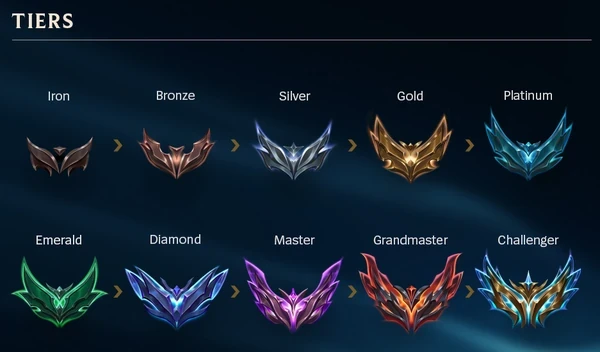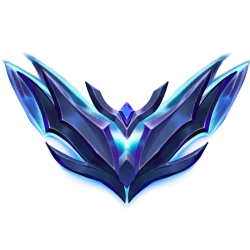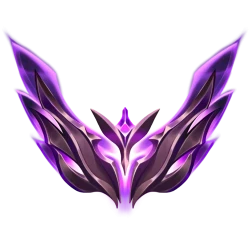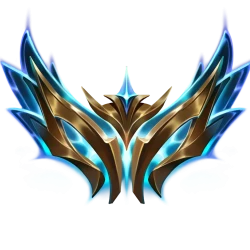

- The Ultimate Guide To LoL Ranking System
The Ultimate Guide To LoL Ranking System

League of Legends Ranks represent a player's skill level and competitive standings. These ranks create a ladder system where players compete to reach higher ranks by winning games. The matchmaking system uses a player's rank to match them with and against other players of similar skill levels.
This is designed to keep games competitive and fair, as matching players randomly could result in unbalanced teams and less fun gameplay. In this article, you will learn what LoL Ranks are, the LoL Ranked System, how it works, and basically everything about League of Legends Ranks, you won't need to read another topic as this covers everything!
What are League of Legends Ranks?

League of Legends ranks put players into different levels based on how good they are at the game. There are 10 main ranks in League of Legends:
- Iron - The lowest rank for new players
- Bronze - For players still learning the basics
- Silver - For players who learned the basics
- Gold - For average players
- Platinum - For good players
- Emerald - A new tier added recently that's above Platinum
- Diamond - For very good players with lots of skill
- Master - For excellent players
- Grandmaster - The 2nd highest tier where only the best players can rank up to
- Challenger - The highest and most exclusive level for the very best players
Iron is the lowest of the ten skill tiers in League of Legends. It sits at the bottom of the ranked ladder below Bronze. Iron tier was introduced in Season 9 of League of Legends in 2019. It was added as the lowest skill rank, situated below the Bronze division. The Iron rank's IV to I divisions now give the newest competitors an environment to learn in while facing equally low-skilled opponents.
The reason League of Legends has this ranked system is to match players up based on actual skill level. This makes games fair and competitive. It also gives all kinds of players milestones to reach. Ranks like Gold or Platinum give people things to feel good about achieving. Good players want to reach the highest ranks like Master or Challenger by being better than millions of others. The ranks give clear targets to aim for each season. Now let's thoroughly explain each LoL rank!
#10 - Iron

Escaping Iron shows a grasp of League’s core elements. While it has jokes around being where bad players sit, it primarily allows new ranked players to be onboarded in an environment not overwhelmed by experts. Learning here sets up advancement if one wishes to climb into the many tiers above. The purpose of adding the Iron rank was to have a dedicated low-skill tier specifically for newly ranked players first entering competitive queues.
#9 - Bronze

The bronze tier follows Iron as the second lowest skill ranking in League of Legends, situated right above the entry-level Iron players. Similar to Iron, the Bronze rank has four numerical divisions from Bronze IV up through Bronze I.
The Bronze tier represents competitors who have a baseline familiarity with League of Legends gameplay, rules, objectives, and champion selection. They have advanced out of the learning environment in Iron by displaying very basic knowledge around farming, vision, team fights, lane matchups, and other fundamentals.
However, Bronze players still do not play particularly effectively. Their grasp of tactics and strategy remains weak with many misplays, errors, and poor decision-making. Things like map awareness, last-hitting, items builds, vision control, and teamplay are haphazard at best. More experienced and skilled opponents will handily control matches against Bronze tier teams.
#8 - Silver

Silver tier comes after Bronze as the third lowest skill ranking right above Bronze I division. Silver introduces four new numeric divisions from Silver IV up to Silver I before reaching the Gold tier.
The Silver skill level represents the point where players have an acceptable conceptual grasp of League of Legends. Silver competitors understand the fundamentals they previously struggled with in Bronze and Iron tiers. Areas like CSing, map movements, vision, and champion mastery start appearing in a semi-competent form among Silver ranked players.
Climbing out of Silver requires truly bettering fundamentals around farm efficiency, vision control, lane assignments, win conditions, and comeback mechanics. This shows a mature past just mimicking what they see strong players do. Advancing to Gold means more critically thinking through plays themselves both individually and collaboratively. For many, settling in high Silver represents their peak skill level commitment.
#7 - Gold

Gold tier follows Silver as the fourth-lowest skill ranking right below the Platinum division. It contains four numbered divisions from Gold IV up to Gold I before reaching Platinum.
Gold represents the level where a player has mastered the fundamentals of League of Legends and developed some intermediate competencies. Gold-ranked competitors display consistency and understanding around vision, farming, trading, power spikes, matchups, and win conditions.
Reaching Platinum from Gold requires sharpening those smart fundamentals and intermediate concepts further while optimizing mechanics. Players must also demonstrate leadership tendencies via shot-calling, vision guiding, objective assignments, and gank pathing for teammates. Maintaining high Gold shows dedication, climbing beyond takes not just skill but leadership and clutch decision-making when ahead or behind.
For players with the time and determination to self-analyze and lead, Platinum and Diamond represent achievable targets. For others, settling in Gold means besting most casual players while lacking the willingness to dictate games themselves.
#6 - Platinum

The platinum tier comes after Gold as the fifth highest skill level out of the ten tiers. There are four divisions within the rank ranging from Platinum IV up to Platinum I.
Reaching Platinum indicates a player has an advanced understanding of macro and micro game concepts. Platinum players have mastered fundamentals like CSing, trading, map movements, and vision control. They also display competent mechanics relative to their role-kiting, skill shots, combo chaining, and target selection.
In addition to that firm grasp of core competencies, Platinum players exhibit strategic decision-making both independently and collaboratively. Their judgments around objective trading, rotation timing, ganks/counter ganks and team compositions are calculated rather than reactionary. Risk assessment improves here to maximize leads.
Platinum is often considered the starting elo where individual mechanical prowess alone cannot carry games consistently anymore. Strategic coordination with teammates through shot calling, vision guiding, and role assignment becomes necessary. Strong fundamentals get optimized here for greater early leads.
Advancing beyond Platinum means perfecting multifaceted coordination and slick reliability in mechanics. For most, obtaining Platinum represents their comfortable peak after reaching expertise in areas they value most. Settling in Platinum demonstrates dedication to growth without pursuing further generalization.
#5 - Emerald

Emerald tier was introduced in Season 13 Split 2 as a new rank between Platinum and Diamond. It has four divisions ranging from Emerald IV to Emerald I.
Reaching Emerald rank signifies a player has mastered fundamental skills and is capable of ranked competitive play at a high level. Emerald players are good in farming, trading, map movements, vision control, and objective coordination compared to ranks below them.
Emerald tests a player's consistency and adaptability against volatile opponents and match situations. Climbing beyond Emerald requires perfecting reliability across one's strengths while continuing to expand strategic capabilities against elite competition.
In essence, Emerald bridges the gap between Diamond skill ceilings and Platinum skill floors. It redistributes the ranked spectrum of League of Legends for more accurate matchmaking and meaningful milestones.
#4 - Diamond

Diamond is situated below Master but above the Platinum I division. Diamond contains four numeric divisions from Diamond IV up to Diamond I.
Reaching Diamond rank means a player has fully refined the fundamentals of the game and developed an advanced strategic mindset. Diamond players are exceptionally reliable across key competencies like farming, vision control, trading, map movements, and champion mastery. Their mechanical ability is extremely crisp as well relative to their chosen role and champions.
In addition to having top-tier fundamentals, Diamond players exhibit highly analytical thinking around win conditions from champion selection through the mid and late-game. Their decision-making and recommendations tend to provide a strong strategic framework for teammates to operate within regarding objectives, rotations, vision lines, and team fights.
Diamond-level performance requires immaculate fundamentals as well as the ability to critically analyze ever-changing conditions during a match to make advantageous judgments for themselves and their teammates. Adapting optimally despite unpredictable opponent decisions tests a Diamond player’s capabilities the most.
For many, Diamond represents the pinnacle blending of skill polish with ingame leadership. Settling at Diamond demonstrates one’s capabilities to optimize talents within a highly competitive environment at an extremely high level compared to 97% of the player base below.
#3 - Master

Master tier represents the top 0.19% of League of Legends ranked player base. It is the third highest skill tier, situated below Grandmaster but above the Diamond I division. Master contains only one numbered division rather than four.
Reaching Master rank demonstrates a player is highly proficient in all aspects of competitive play - from fundamentals to complex strategy and leadership. Master-tier competitors exhibit exceptional reliability in their role and champion pool with crisp mechanics. Choices around trading, farming, vision, macro movements, and micro outplays are nearly perfectly optimized, even under high-pressure situations.
In addition to their technical excellence, Master players must display strong analytical skills to dictate winning conditions and disadvantageous states for their team. Their ability to recognize key power spikes, win conditions, and timing windows and then track those moments in real time relies on sharp strategic tendencies.
Because the Master tier houses top competitors and premade teams (in Flex mode), maintaining the rank demands extensive consistency while also outsmarting and outmaneuvering equally skilled or superior teams. Adapting optimally despite unpredictable shifts separates resilient Master tier players from climbing further.
Settling into Master rank puts a player comfortably within the top 1% of League's player base worldwide. It serves as a platform to pursue Grandmaster without fear of slipping far.
How Does Master Work in League of Legends?
To reach Master in League of Legends, you will need to pass Diamond I. Players in Master compete for LP (League Points) to move up in the standings. Whoever earns the most LP has the highest Master rank.
And every day, Master players with the most LP get to move up to Grandmaster rank above them. They replace whoever were the lowest LP Grandmaster players. So it is very tough to stay above Master as better players keep replacing those at the bottom.
#2 - Grandmaster

Grandmaster tier represents the top 0.018% of League of Legends ranked player base. It is the second highest skill tier, situated below Challenger but above Master tier.
Reaching Grandmaster indicates a player has essentially mastered all aspects of League at an elite level. Grandmaster competitors exhibit flawless reliability in their role and champion pool with exceptionally crisp mechanics. Their choices around trading, farming, vision, macro and micro play are hyper-optimized even in high-pressure situations.
In addition to their technical prowess, Grandmaster players display genius-level strategic decision-making ability. They dictate optimal winning conditions and disadvantageous states for their team at the highest conceptual level. Integrating teammates into those plans relies on sharp shot-calling and leadership tendencies.
Staying in Grandmaster demands outsmarting the absolute best players using extensive matchup knowledge and snap judgment calls. Seamlessly adapting to unpredictable opponent strategies by perfectly balancing farming, fighting, vision, and objective control separates resilient Grandmasters climbing into Challenger.
Settling into Grandmaster rank puts a player comfortably within the top 0.05% of League's player base worldwide. It serves as an exclusive club where individual greatness gets leveraged through coordinated team play at the peak level. Grandmaster represents the doorstep to genius IQ gameplay found in Challenger above.
For those with great ambition and dedication, Grandmaster offers a platform to pursue the highest glory. For others, reaching it proves their place among elite strategic minds and mechanical prodigies.
#1 - Challenger

The Challenger tier represents the absolute peak of League of Legends competitive gameplay. It comprises the top 0.0025% of ranked players on the ladder. Challenger sits above all other tiers as the sole gateway to professional-level play.
Reaching Challenger indicates a player has essentially solved League at the highest conceptual level across all strategic and mechanical fronts. Challenger-level competitors exhibit effortlessly flawless play in their role and champion pool. Their trade timing, farming patterns, vision setups, and map movements flow optimally as second nature no matter the game state.
In addition to their technical mastery, Challenger players demonstrate genius-level IQs in analyzing winning conditions. Their ability to recognize key objectives, power spikes, item spikes, and win conditions and then track those perfectly in real-time relies on lightning-fast analysis mated with extreme game knowledge.
Remaining in Challenger demands outmaneuvering the world's absolute best players using creative strategies and counter-intuitive optimization. Seamlessly adapting hypotheses and plans by perfectly balancing early vs late win conditions separates the elite advancing to qualifying for organized pro play.
Reaching Challenger rank puts a player comfortably within the top 0.01% of League's player base. Challenger represents the only public stage to display capabilities surpassing 99.9% of competitors for scouting onto professional teams. It sits atop the ranked ladder with mythical status for good reason.
How Many Challengers are in League of Legends?
Reaching the top Challenger tier in League of Legends represents the pinnacle of competitive-ranked play. But with millions of players across over a dozen regional servers, having an uncapped Challenger tier would lose meaning and prestige. Here is the breakdown of the maximum number of players allowed in the Challenger tier on each region's server:
EUW (Europe West) Server
- Solo/Duo Queue Challenger spots: 300
- Flex Queue Challenger spots: 200
EUNE (Europe Nordic & East) Server
- Solo Queue Challenger spots: 200
- Flex Queue Challenger spots: 50
BR (Brazil) Server
- Solo/Duo Queue Challenger spots: 200
- Flex Queue Challenger spots: 200
JP (Japan) Server
- Solo/Duo Queue Challenger spots: 50
- Flex Queue Challenger spots: 50
KR (Korea) Server
- Solo/Duo Queue Challenger spots: 300
- Flex Queue Challenger spots: 200
LATAM-N (Latin America North) Server
- Solo/Duo Queue Challenger spots: 200
- Flex Queue Challenger spots: 50
LATAM-S (Latin America South) Server
- Solo/Duo Queue Challenger spots: 200
- Flex Queue Challenger spots: 50
NA (North America) Server
- Solo/Duo Queue Challenger spots: 300
- Flex Queue Challenger spots: 50
OC (Oceania) Server
- Solo/Duo Queue Challenger spots: 50
- Flex Queue Challenger spots: 50
RU (Russia) Server
- Solo/Duo Queue Challenger spots: 50
- Flex Queue Challenger spots: 50
TR (Turkey) Server
- Solo/Duo Queue Challenger spots: 200
- Flex Queue Challenger spots: 50
League of Legends Ranks Distribution
Every competitive rank in League of Legends comprises a certain percentage of the ranked player base. Based on statistics from Leagueofgraphs, here is the distribution across the LoL ranked tiers:
- Challenger - 0.0031%
- Grandmaster - 0.021%
- Master - 0.21%
- Diamond - 3.8%
- Emerald - 11%
- Platinum - 19%
- Gold - 20%
- Silver - 18%
- Bronze - 18%
- Iron - 6.6%
How Does LoL Ranked System Work?
The main goal of the ranked system is to match players with others of a similar skill level for fair and competitive games.
When you start playing ranked, you first play 5 placement games. Based on wins and losses in these, the game assigns you an initial rank to start the season.
Ranks are broken into 4 divisions, progressing from Division 4 up to 1. For example, advancing from Gold 4 to Gold 3 signifies upward movement in Gold rank.
As you win games, you gain LP (League Points) to progress through ranked divisions.
If you are at 90 LP in Emerald 2 division and gain 25 LP from a win, you will be promoted to Emerald 1 at 16 LP. You also get a +1 LP rank up bonus.
However, upon reaching Emerald 1 90 LP, if you gain 25 LP from a win, you will be promoted to Diamond 4 at 1 LP. In division 1 of any rank, excess LP does not carry over on promotion.
This means divisions progress as follows:
Emerald 2 90 LP + 25 LP = Emerald 1 16 LP
Emerald 1 90 LP + 25 LP = Diamond 4 1 LP
There are no longer promotion series. If your LP gains take you over 100 points while below division 1, you rank up with a small LP bonus. But at max division 1 LP, it resets you to 1 LP at the next rank.
League of Legends Demotion Explained
A demotion is the opposite of a promotion - it's when you drop down from your current division to the next lower one due to losing too many games. For example, falling from Gold III down to Gold IV.
if you lose games at 0 LP, you will be demoted down a division. Typically this occurs after 1 loss at 0 LP but could take 2-3 losses if your hidden MMR remains higher than your current rank.
Demotions feel bad but are meant to keep the integrity of rankings intact. Players can climb back out by improving their play and winning more games. Focusing on a growth mindset allows you to regain lost progress.
The threat of demotions gives weight to the accomplishment of achieving new promotions. Players have to continually prove themselves to maintain higher ranks or else slide backward down the ladder. Both promotion milestones and demotion pitfalls are what give ranked its highs and lows.
LoL Ranked: Solo/Duo vs. Flex Queue
Solo/duo queue is designed for individual competition and tests single-player skill levels. You are only allowed to queue up alone or with one other person. The rank earned here is viewed as an accurate reflection of personal capability as a League player.
Flex queue allows teams of 1, 2, 3, and, 5 players to queue up together and be matched vs other groups. It serves as League's more casual form of ranked team play without stringent restrictions on group size.
How To Dodge in LoL Ranked Gamemode?
Dodging in League of Legends can be done by clicking the exit button in the upper right corner and then confirming it when prompted or by not locking a champion during the champion selection phase.
The main reasons players choose to dodge games include:
- Your designated role was taken and you don't want to play something else
- Your team composition seems very poor
- A teammate is expressing clear trolling intentions through abusive chat and champion hovers
We have an article on the "Dodging Definition" that you might want to check to learn more about Dodging in League.
How to Get The Most LP in Ranked Matches?
Climbing the ranks in League of Legends can be a long and tricky endeavor. As you play placement matches and get settled into a division and tier, you'll start your journey gaining and losing League Points (LP) with each match.
But LP gains and losses can feel arbitrary or different from game to game. Why do you gain only 25 LP for a win when yesterday you got 20? What exactly impacts how much LP you win and lose?
Well, there are definite strategies and best practices you can implement to optimize and accelerate your LP earnings to climb faster. By focusing on a few key areas and being intentional with your play, you can swiftly amass LP and hit new rankings. Here are some of the top tips for how to best gain LP in your League of Legends ranked matches and continue advancing up the ladder:
- Win games: This is the most basic way to gain LP and what matters the most. You gain LP when your team wins and lose LP when your team loses. So focusing on winning as much as possible is key.
- Play carry roles: If you play roles that can heavily influence the outcome of the game like mid, jungle, or ADC, you have more personal agency to win games and gain LP.
- Duo queue: Having a reliable duo partner makes it easier to coordinate and win games. Find someone you synergize well with. But beware this also makes your opponents harder.
- Getting a fresh MMR optimized account: This can help greatly - the LP gains on a fresh LoL account with good MMR and win rates are much better. So this strategy can definitely boost how fast you climb.
Final Words
We hope this big guide on all the League of Legends ranks was helpful! We wanted to explain everything about how ranked works in one place. Now you know all about how ranked matches players by skill and what it takes to climb ladder! Understanding the system better can make grinding feel more rewarding. Focus on getting better through play and learning every game. The ranks will come over time by sticking to it. Good luck on the Rift summoners!
What now? You're done reading but we have more for you to read. We have lots of informative content that you could learn from. Looking to move up the ranks quickly? Try our LoL Boosting services. It's a simple and fast way to boost your rank. See how high you can go with our help!
“ GameBoost - Muhammad Nagi is a gamer-turned-organic growth hacker with a passion for performance, strategy, and persistence. With over 8,000 hours in CS:GO, he knows what it means to grind — and he applies that same energy to digital growth. Drawing from years of in-game experience, Muhammad now uses his deep understanding of gamer behavior to educate others, build visibility for gaming brands, and deliver actionable content that resonates with real players.”


